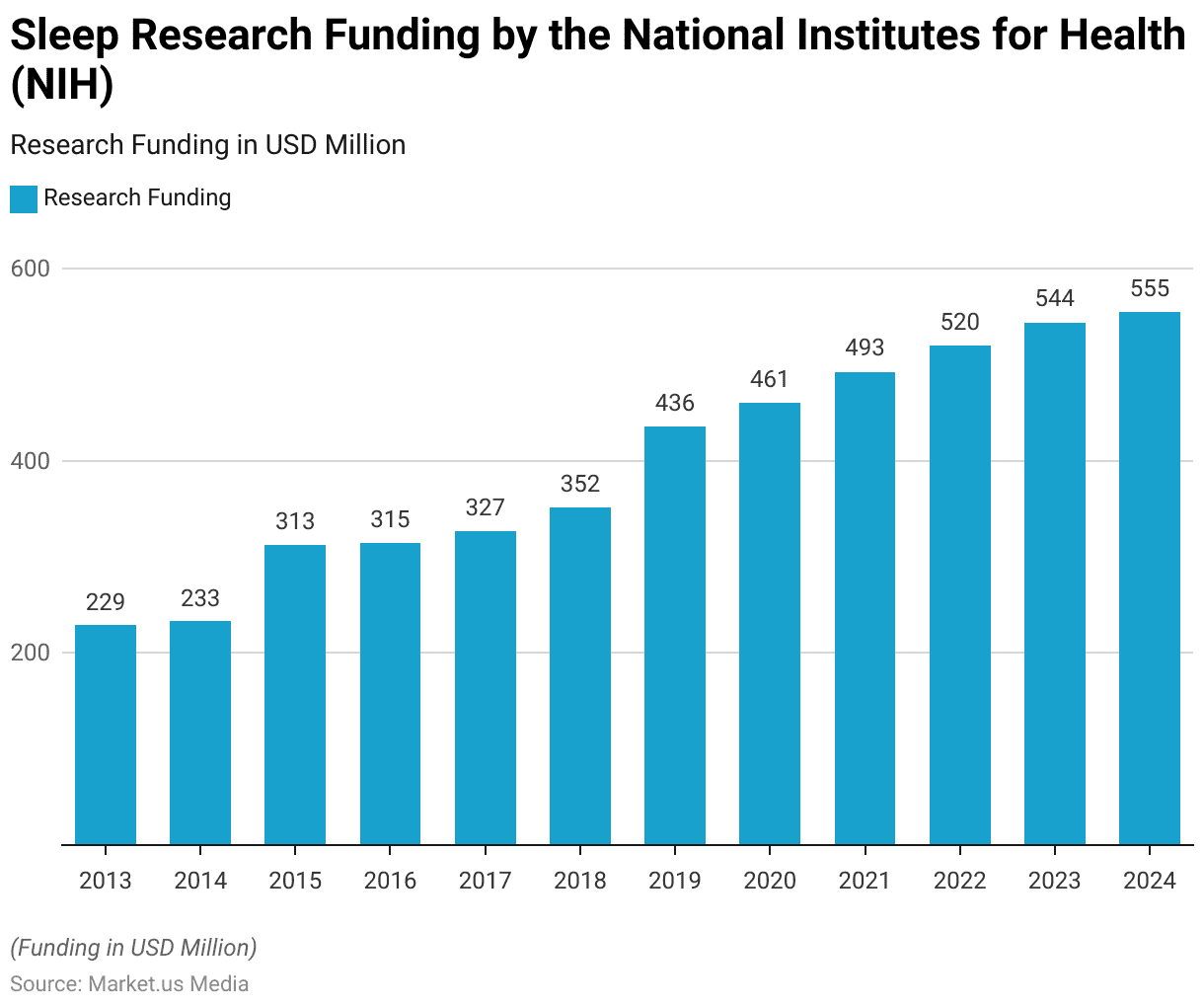Table of Contents
Introduction
According to Sleep Medicine Statistics, Sleep medicine is a medical field focused on diagnosing and treating sleep-related disorders.
It deals with various issues like insomnia, sleep apnea, narcolepsy, and restless legs syndrome. Diagnosis involves tests like sleep studies, while treatments range from lifestyle changes to medications.
Collaboration with other medical specialties is common in addressing sleep disorders, and research in this field is ongoing.
Public health awareness and access to care are important aspects, and the field is evolving with emerging trends and technology.
Sleep medicine plays a vital role in improving individuals’ overall health and quality of life by addressing sleep-related issues.
Editor’s Choice
- Approximately 8% of adults have reported using medication to assist with their sleep on at least four occasions within the past week.
- Approximately 20% of adults opt for marijuana or cannabidiol (CBD) to aid their sleep, and 23% have turned to Benadryl (diphenhydramine) as a sleep aid in the past month.
- In individuals aged less than 60 years, the prevalence of sleep disorders stands at 17.2%, while those without sleep disorders make up 43.3% of this age group.
- According to a survey conducted by SleepFoundation.org, 58% of individuals with seasonal affective disorder rely on sleep aids, while only 26% of those without the disorder use them.
- Additionally, 79% of adults who take prescription sleep medication encounter lingering effects such as excessive sleep, grogginess, or difficulty concentrating the following day.
- Among adults aged 18-24, approximately 40% have reported using sleep medications, while the prevalence is slightly higher in the 25-34 age group at 45%.
- The NIH’s commitment to sleep research remains evident, with funding projected to reach 544 million USD in 2023 and 555 million USD in 2024.
Prevalence of Sleep Disorders
Insomnia Statistics
- Between 30% to 50% of adults may experience occasional short-term insomnia during their lives.
- According to the American Academy of Sleep Medicine (AASM), in adults experiencing insomnia, about 30-35% have brief episodes of insomnia.
- Approximately 15-20% encounter short-term insomnia that persists for less than three months.
- Around 10% grapple with a chronic insomnia disorder, enduring it at least three times a week for a minimum of three months.
Sleep Apnea Statistics
- Around 39 million adults in the United States are affected by obstructive sleep apnea (OSA), while the global estimate for mild to severe OSA is approximately 936 million adults.
- Over two decades from 1993 to 2013, there were notable changes in the prevalence of obstructive sleep apnea (OSA) among U.S. adults aged 30 to 70 years old.
- Among men, the prevalence increased from 9% in 1993 to 13% in 2013, representing a substantial 27% increase.
- Similarly, among women, the prevalence also saw an upward trend, rising from 4% in 1993 to 5% in 2013, marking a 25% increase.
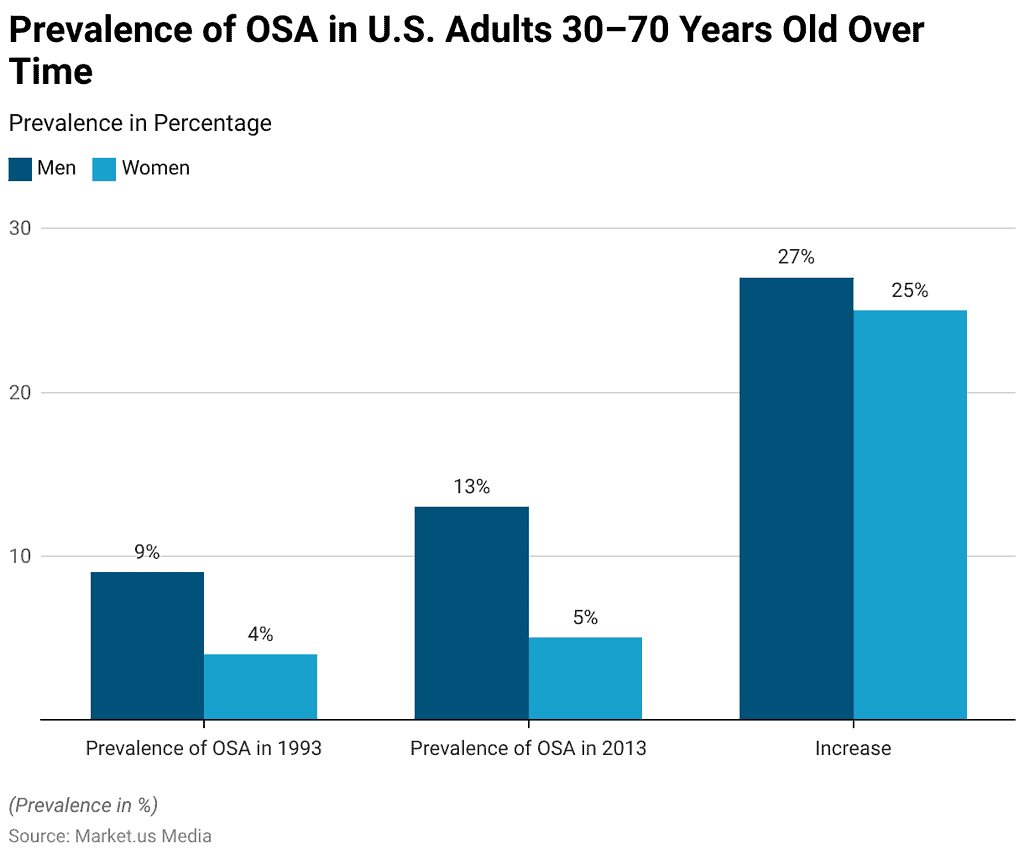
Restless Legs Syndrome (RLS) Statistics
- Roughly 7-10% of the U.S. population is believed to experience Restless Legs Syndrome (RLS), a condition that can onset at any stage of life. It affects both males and females, with a somewhat higher likelihood in females.
- Many individuals who suffer severely from RLS are in their middle age or older, and as they age, the symptoms tend to become more frequent and endure for longer durations.
- Over 80% of individuals with Restless Legs Syndrome (RLS) also encounter periodic limb movement during sleep (PLMS).
Narcolepsy Statistics
- Narcolepsy is estimated to affect 1 in every 2,000 individuals in the United States, translating to around 200,000 Americans and approximately 3 million people globally.
- It’s worth noting that only a quarter of those who have narcolepsy receive a diagnosis and treatment, leaving many undiagnosed.
- Narcolepsy can be categorized into two types: Narcolepsy Type 1 (with Cataplexy) and Narcolepsy Type 2.
- Symptoms typically manifest between the ages of 10 and 30, but narcolepsy can onset at any age, and it is often misdiagnosed.
Parasomnias Statistics
- Parasomnias impact around 10% of the U.S. population and can occur in individuals of all age groups, although they tend to be most prevalent among children.
- The prevalence of parasomnias varies between the pediatric and adult populations, with several types being observed.
- In adults, the lifetime prevalence of sleepwalking is approximately 22.4%, while in children under the age of 15, it affects around 17% of them.
- Similarly, confusional arousal is prevalent in approximately 18.5% of adults and 17.3% of children. Sleep terror, another type of parasomnia, occurs in about 10.4% of adults and is reported in 6.5% of children.
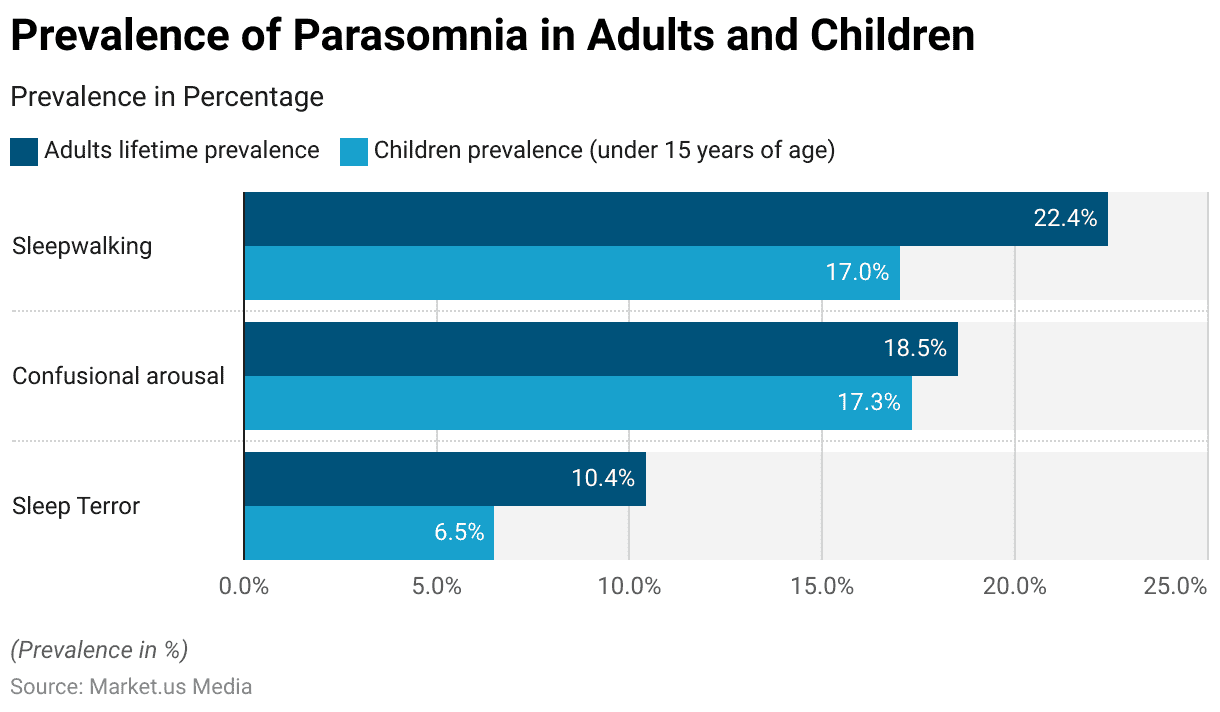
Risk Factors for Sleep Disorders
Age and Sleep Disorders
- In individuals aged less than 60 years, the prevalence of sleep disorders stands at 17.2%, while those without sleep disorders make up 43.3% of this age group.
- Conversely, in individuals aged 60 years and older, a significantly higher proportion, 82.8%, experiences sleep disorders, while 56.7% do not report any sleep disorder.
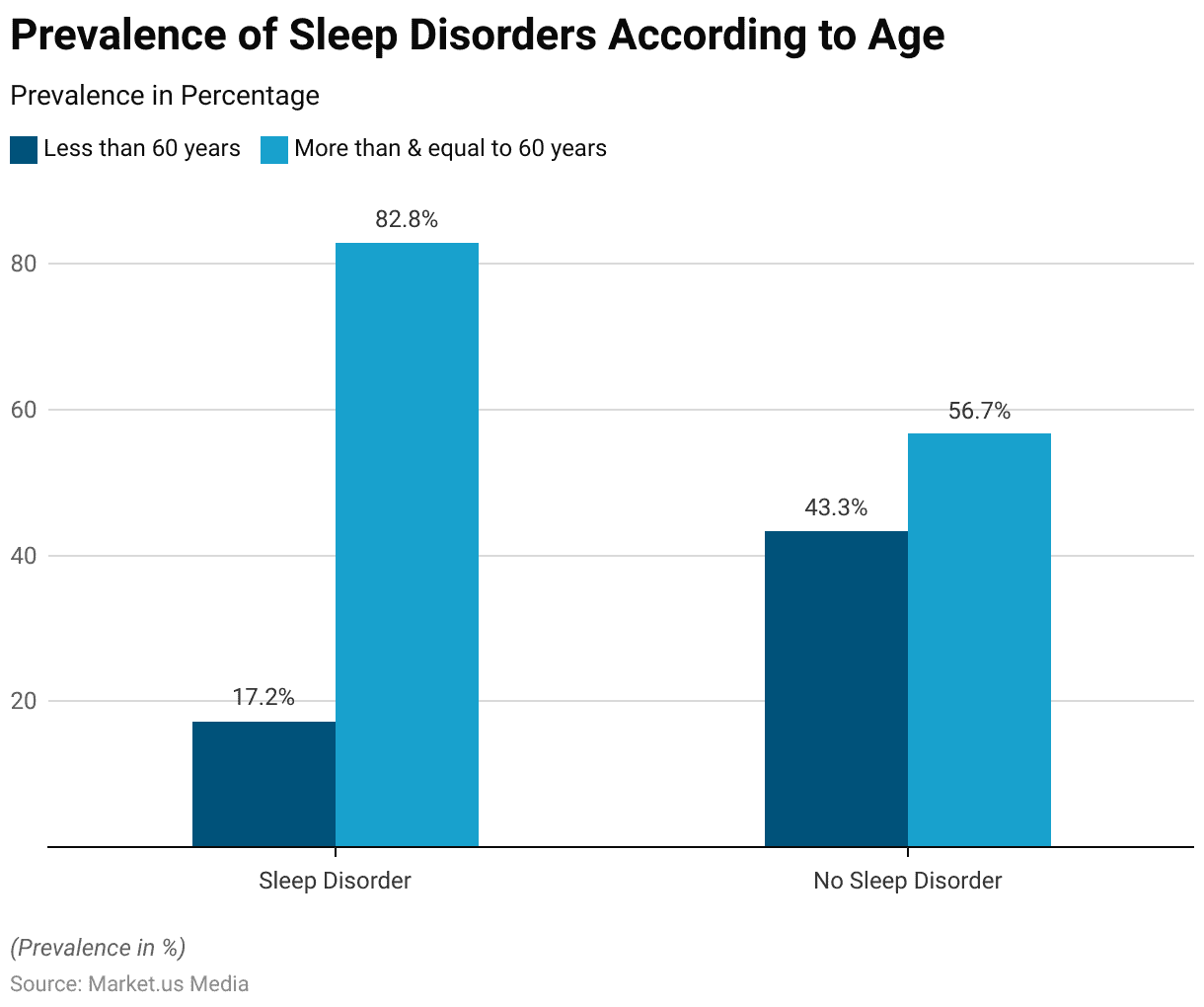
Gender Disparities
- In the United States as of 2022, the reported prevalence of select sleep issues among adults varies by gender.
- Among males, 51% reported having no trouble sleeping, while 12% reported experiencing trouble sleeping, 28% had trouble staying asleep, and 9% had difficulty both falling and staying asleep.
- On the other hand, among females, 41% had no trouble sleeping, 17% reported trouble sleeping, 29% had difficulty staying asleep, and 13% faced challenges with both falling asleep and staying asleep.
- In the total population, comprising both genders, 46% reported no trouble sleeping, 15% reported trouble sleeping, 28% experienced difficulty staying asleep, and 11% had trouble both falling asleep and staying asleep.
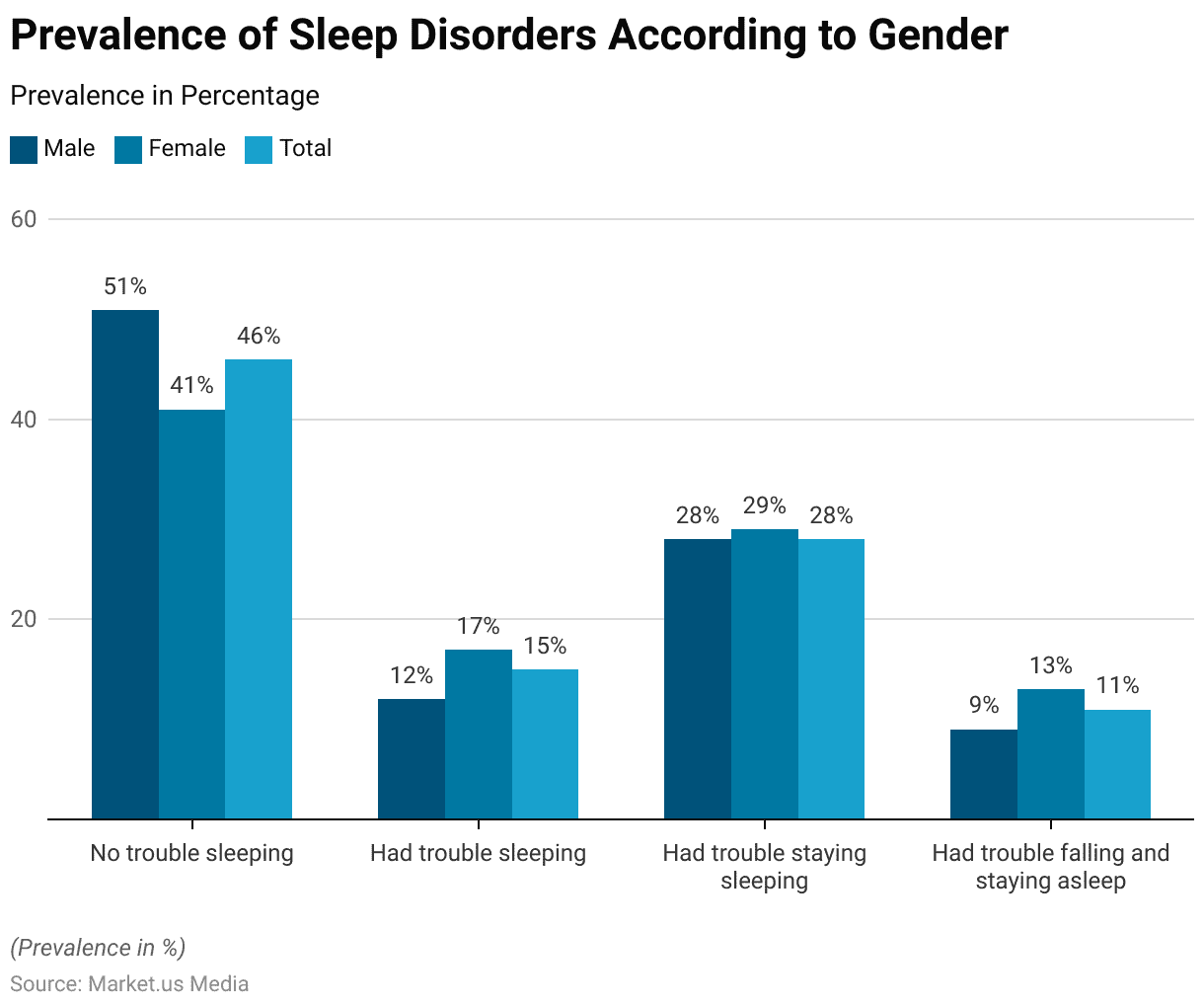
Obesity and Sleep
- In the United States, the prevalence of obesity exceeds 40%, while approximately 21% of the population is affected by a sleep disorder. (Source: CDC)
- Remarkably, among individuals diagnosed with obstructive sleep apnea, a prevalent and potentially life-threatening condition, more than 70% are also affected by obesity.
Sleep Aids and Sleep
- Approximately 8% of adults have reported using medication to assist with their sleep on at least four occasions within the past week.
- According to a survey conducted by SleepFoundation.org, 58% of individuals with seasonal affective disorder rely on sleep aids, while only 26% of those without the disorder use them.
- Additionally, 79% of adults who take prescription sleep medication encounter lingering effects such as excessive sleep, grogginess, or difficulty concentrating the following day.
- Approximately 20% of adults opt for marijuana or cannabidiol (CBD) to aid their sleep, and 23% have turned to Benadryl (diphenhydramine) as a sleep aid in the past month.
- The sleep tracker industry is anticipated to reach a substantial value of $11.2 billion by 2028, with 28% of adults utilizing cell phones, including sleep-tracking apps, to monitor their sleep patterns.
Demographics of Sleep Medicine
By Age Group
- The utilization of sleep medicines varies across different age groups, as indicated in the survey responses conducted by the American Academy of Sleep Medicine.
- Among adults aged 18-24, approximately 40% have reported using sleep medications, while the prevalence is slightly higher in the 25-34 age group at 45%.
- In the 35-44 age bracket, 41% have used sleep medicines, while the percentage decreases in the 45-54 age group (32%) and the 55-64 age group (34%).
- Among adults aged 65 and above, only 15% have used sleep medicines.
- Conversely, a larger proportion of individuals in the older age groups, specifically those aged 45 and older, reported not using sleep medicines, with percentages ranging from 61% to 80%.
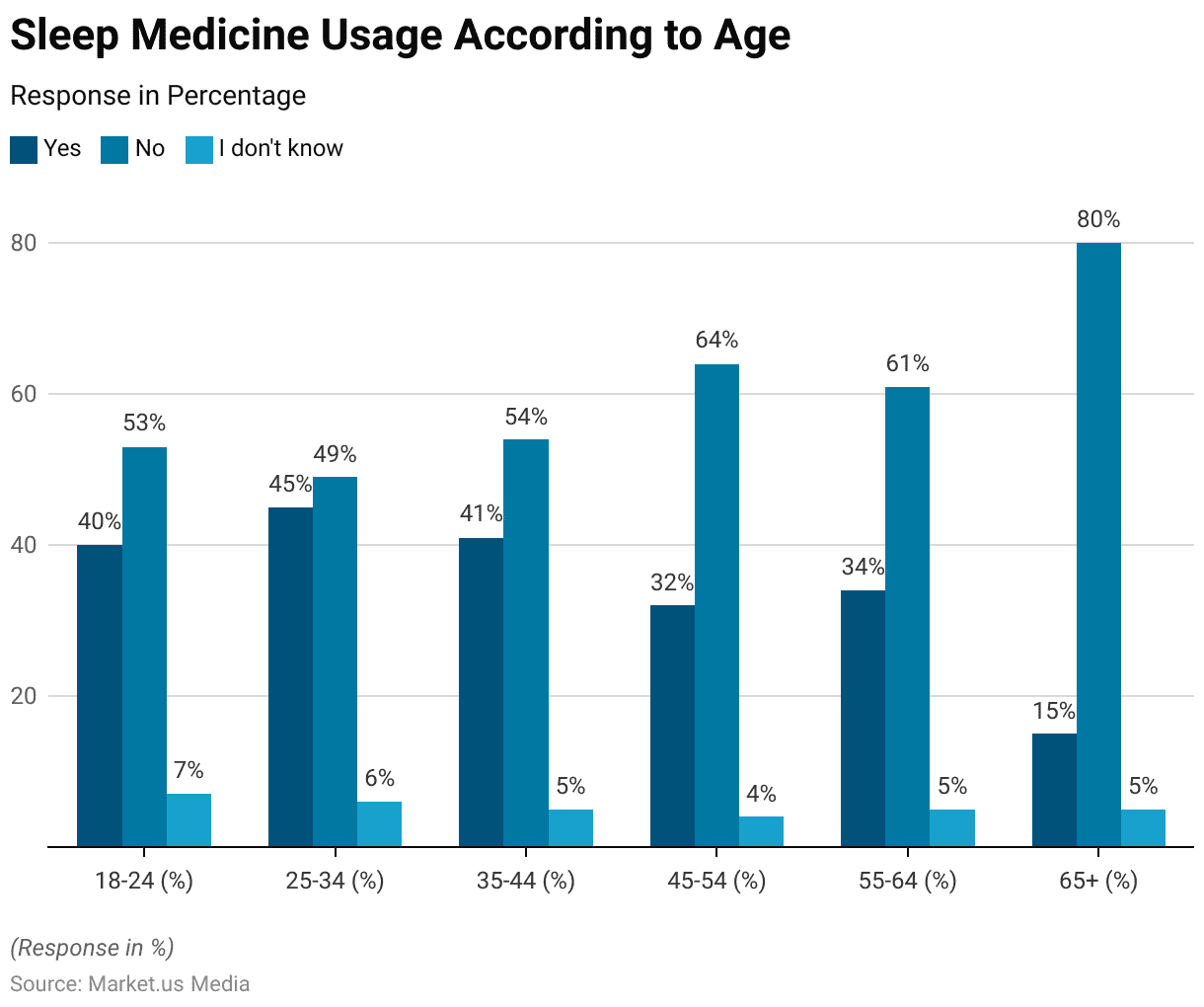
By Gender
- When it comes to the usage of sleep medicines, gender differences appear to be relatively minimal.
- Among males, 37% have reported using sleep medications, a percentage mirrored closely by females, also at 37%.
- The majority of both genders, with 58% of males and 57% of females, indicated that they do not use sleep medicines.
- A small proportion of respondents from both groups expressed uncertainty, with 5% of males and 6% of females stating that they did not know.
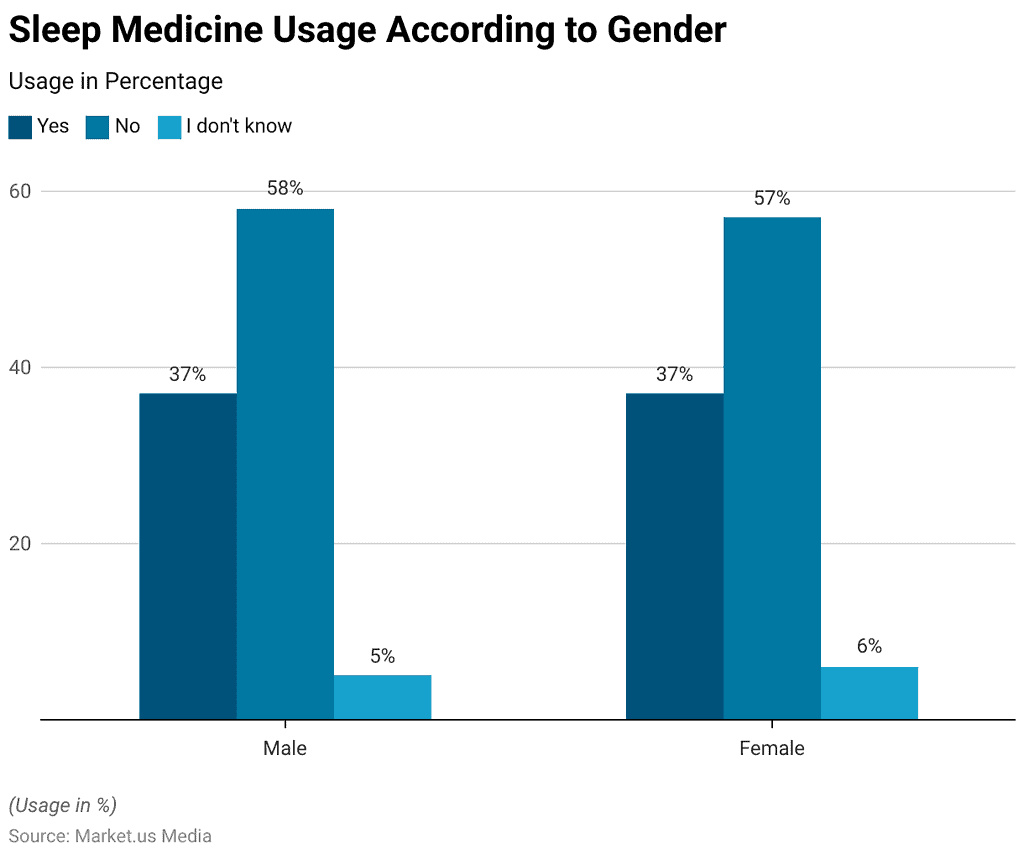
Sleep Research Funding
- In 2013, the NIH allocated 229 million USD to support research projects aimed at understanding various aspects of sleep, from its underlying mechanisms to its impact on physical and mental well-being.
- This upward trajectory was maintained with allocations of 461 million USD in 2020, 493 million USD in 2021, and 520 million USD in 2022, indicating a continued dedication to studying sleep and its impact on health.
- Looking ahead, the NIH’s commitment to sleep research remains evident, with funding projected to reach 544 million USD in 2023 and 555 million USD in 2024.
